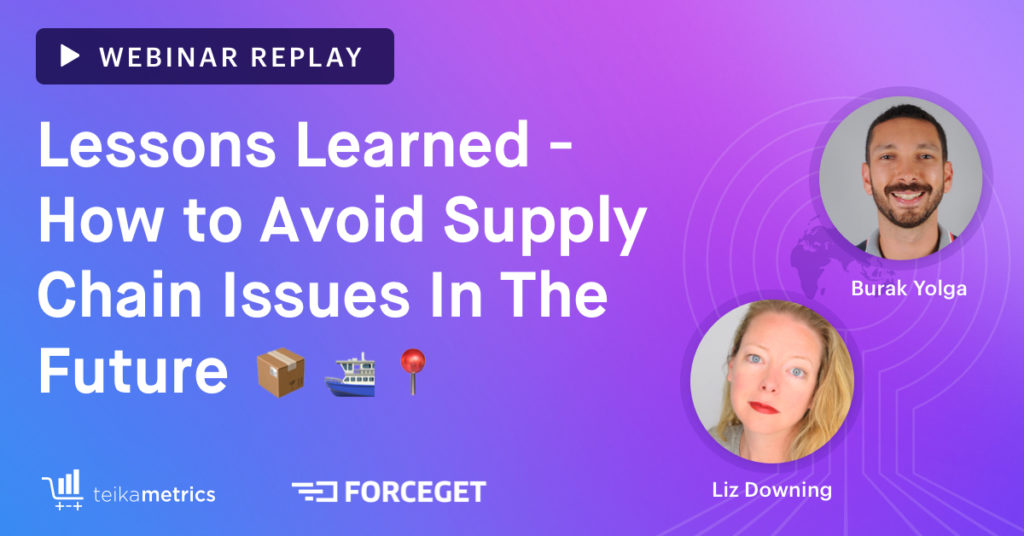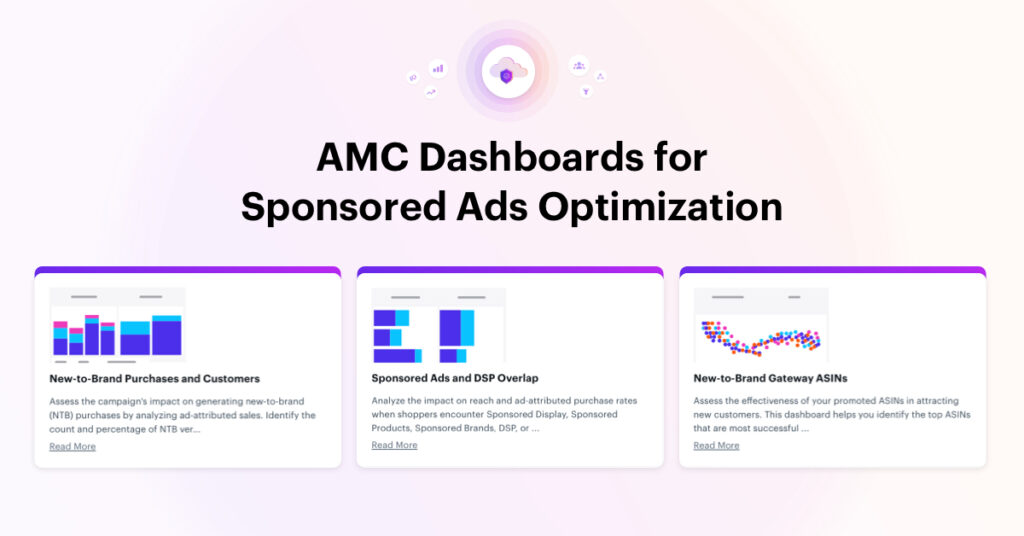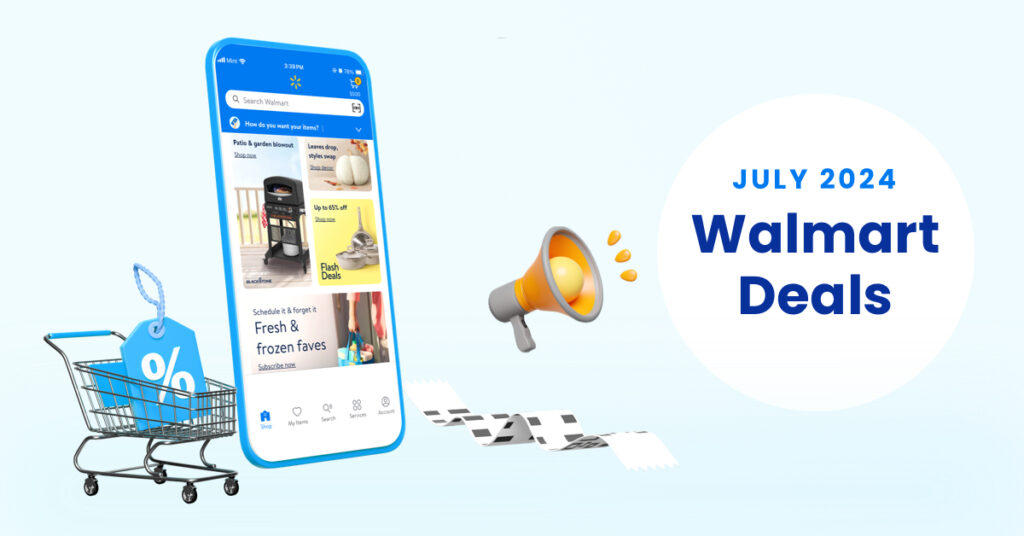Supply chain issues and delays are on every ecommerce professional’s mind these days. We’re in the midst of Q4, and some items simply aren’t going to make it onto the shelves at Amazon.
Despite the frustration, we can learn from these trying times. In this webinar, Burak Yolga, Co-Founder at Forceget, joins us to discuss the most important lessons you can glean from your challenges in order to avoid future supply chain issues.
What we cover:
- An update on the status of US ports (LA, Miami, New York…)
- Outlining countries that offer potential alternative sourcing options
- Keys to optimizing shipping costs from China
- What Amazon FBA sellers should know about 2022
Show Notes:
- Follow Burak Yoga, Co-Founder, Forceget
- Follow Liz Downing, Ecommerce Marketing Manager, Teikametrics
- Follow Cameron Yoder, Digital Community Manager, Teikametrics
- Read Burak’s blog How To Optimize The Cost of Shipping From China To Amazon FBA
Read Liz’s guide Amazon International Marketplaces: A Seller’s Guide
Watch the Full Replay:
Read the Webinar Highlights:
Supply chain challenges are apparent to anyone who shops
Shoppers are feeling the lack of products and increase in costs wherever they shop.
“You go to the grocery store, you go to the coffee shop, you go to a restaurant. You realize prices are getting inexpensive, right? And then you’re like where this is coming from? Now everybody’s talking about the inflation and other things. Obviously, I’m not gonna go into economy 101, but where this entire thing is coming from, it’s actually a result of what had been issues with supply chain and international logistics.” -Burak Yolga
Sellers have increased prices to account for increased shipping costs
With the cost of shipping a container from China to the U.S. increasing dramatically, many sellers have had to increase their prices or risk losing money.
“Obviously, ecommerce and Amazon sellers, they have to stay on top of the pricing, the game, the competition, so that people who don’t want to actually increase their prices, not to lose their rankings and et cetera. But at some point… we hear that everybody had to increase their price, because they don’t even have margins anymore to just sacrifice to stay in the competition. It was either going to increase the price, are going to start losing money. Obviously, nobody is doing this business to lose money.” – Burak Yolga
The backup at the port in L.A. is due to a lack of drivers
Containers can’t leave the port without trucks and drivers which are both lacking, and drivers are having to wait in line for hours to get a container and remove it from the port.
“So, the problem is mainly of the local operations in Long Beach Port. There’s not enough drivers. There’s not enough trucks, There’s not enough chassis to put the containers on to transport inside the country. And especially recently, President Joe Biden announced that the Los Angeles Port is going to work seven days, 24 hours. However, that’s not going to be a solution because still there’s not enough drivers. There’s no enough. And most of these people are the lowest paid job. It used to be at least. Now they are making some more money. But in order to go into the port, pick up a container, it’s roughly 5 to 7 hours waiting time. So all these people are waiting in their trucks, very inefficient. Very like cost-friendly, not cost-efficient. So all these companies, truck companies, the terminal workers, they are all overwhelmed with this backlog of the problems going on.” -Burak Yolga
Supply and demand have both contributed to the situation
Burak explained that changing demand during the pandemic exacerbated existing shipping and logistics issues.
“If you think about these backlogs and these problems, terminal, the shortage, it actually started back in 2017 to 2018. But nobody really felt tit because the demand and supply were pretty much balanced. But with Covid, especially Chinese market, they shut down maybe almost 2 to 3 months. And so many cities, there was no access. So employees couldn’t go back…
While China was closed for 2 to 3 months people in that actually started decorating their house, buying stuff, renovating everything, painting the walls, and suddenly there was a big demand. So with the support of the government, all this, you know, free money is given to people. So people actually started spending that money to push the economy. So it happened at the same time. And there was a huge spark suddenly that nobody actually could catch up with.” -Burak Yolga
Shoppers are returning to brick-and-mortar stores
Knowing that supply and delivery have become such big issues for online shopping, many shoppers are going back to brick-and-mortar stores to ensure they can get gifts on time.
“The retail stores – brick and mortar stores – have been busier because everybody’s afraid if they order online, they’re not gonna get what they ordered in time for whatever they ordered it for Christmas or birthdays or whatever. So, I am seeing, sort of a return to shopping in person, at least where I live in Richmond, Virginia, and I’ve talked to people, like, why is there a line out of Ann Taylor, when there’s not a sale today? What are all you people doing at Walmart buying household products when you can order them from Walmart online? And I actually talk to people like why are you here in person, and they say, It’s because we know we can get it now.” -Liz Downing
Shipping prices are volatile
Burak explained that he used to be able to give fixed shipping prices, but now they’re changing from day to day.
“At the moment, the ocean prices went down, almost 30 to 40%. Three to four months ago a full container to California was $18,000, $20,000. Now, we’re looking at $11,000, $12,000, This week is a little bit increasing. Years ago, we used to actually have every two weeks the standard price that we can send to our customer and we keep it, but now, price changes every day. So, you asked me the price today, we try to book it, by the time we get the booking from the shipping line, it might change. That’s a problem right now with the industry.” – Burak Yolga
Even customs is delayed
Burak explained that delays at U.S. customs not only take time but they can be costly becuase of additional days of stroage needed.
“Another thing is, a lot of people actually don’t think about it, but also custom clearance in US side, it takes longer than usual, because the system is backed up. It used to be within the same business day into the custom things. But now it takes two to four business days. So that also causes storage charges in the destination. So people should be really careful with the right fit for their choosing a custom broker, that everything should be really smooth.” -Burak Yolga
Plan for continued delays and price increases
Advice from Burak is to plan and order earlier than you used to. Raw materials prices are expected to rise so if you have the cash flow to buy those materials now you can save money.
“I really highly recommend people to plan their production forecast now. Don’t wait until middle of December, end of December, if you have enough cash flow, place an order now, big quantity of the raw material. Let’s say if you order a backpack, make sure you ordered polyester – if you’re going to sell 10,000 units, make sure you order at least half of it, even if you don’t need it, immediately, so, you can fix the price.” -Burak Yolga
Recalculate your margins
With so many macroeconomic forces outside of a sellers’ control, what can a seller focus on and really control? Burak says it’s important to do the math and understand how changes to shipping costs affect your margins.
“I really think that people should be very careful with their cash flow. That’s one thing, people should manage their cash. People should manage their money, correctly. And I think they need to sit down, compare how much they were actually paying two years ago for a product, and how much they’re paying shipping cost per item. And how much are you doing? How much are you paying for that now? And you need to check the increase and see that the trend. The trend is going the same way. I think that’s one of the most important things.” -Burak Yolga





